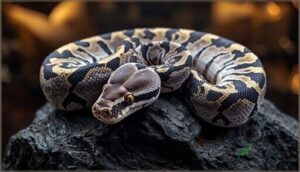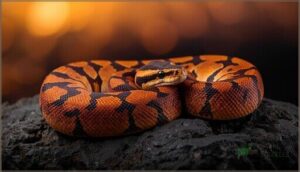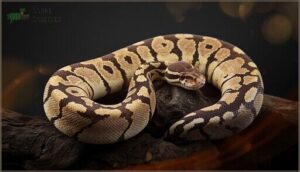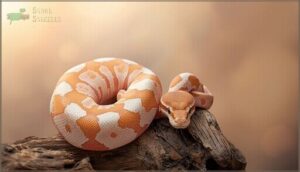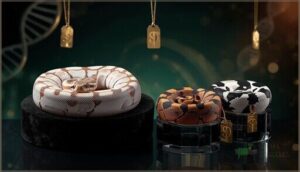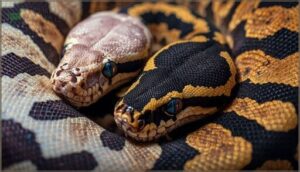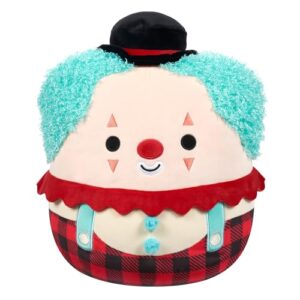This site is supported by our readers. We may earn a commission, at no cost to you, if you purchase through links.
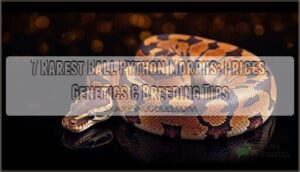
A single ball python morph once sold for $125,000—not because it came with superpowers, but because its genetics were that rare. The ball python morph community operates like a high-stakes art market, where breeders hunt for specific gene combinations that produce stunning visual traits.
Some morphs hit the scene at eye-watering prices before stabilizing as more breeders crack the genetic code. Right now, the most expensive and rarest ball python morph specimens command anywhere from $5,000 to $20,000, depending on their genetic complexity and visual impact.
Understanding what drives these prices helps you make smarter decisions whether you’re breeding, collecting, or simply fascinated by these living works of art.
Table Of Contents
- Key Takeaways
- Most Expensive and Rarest Ball Python Morphs
- Factors Affecting Ball Python Morph Prices
- Genetics and Appearance of Rare Morphs
- Top 5 Ball Python Collectibles and Novelty Items
- Frequently Asked Questions (FAQs)
- Are ball python morphs expensive?
- Are monsoon ball pythons rare?
- What is the rarest ball python morph?
- Are ball pythons rare?
- Are ball pythons considered rare?
- Are ball pythons generally expensive?
- Is a specific ball python morph rare?
- How much does a ball python morph cost?
- How much does a Stranger Ball Python cost?
- How many morphs does a Ball Python have?
- Conclusion
Key Takeaways
- Ball python morph prices range from $65 for common varieties to $20,000+ for rare specimens like Stranger and Monsoon, driven by genetic complexity, breeding difficulty, and scarcity rather than arbitrary market hype.
- Recessive gene morphs are exponentially harder to produce—double recessives hit only 6.25% probability per clutch, meaning breeders can spend entire seasons with zero target offspring, justifying premium pricing.
- Multi-gene “designer” morphs command the highest prices because stacking multiple traits compounds rarity mathematically, while three-to-five-year maturity windows mean years of investment before any return.
- The market operates like high-end art collecting where early adopters pay top dollar for new combinations before supply normalizes, but extreme rarities with limited founder stock maintain astronomical values indefinitely.
Most Expensive and Rarest Ball Python Morphs
You’ve probably heard that some ball pythons can cost as much as a used car, and it’s true. The rarest morphs combine unique genetics with stunning patterns that collectors can’t resist.
Let’s look at seven of the most expensive and sought-after ball python morphs in the hobby today.
Stranger Ball Python Morph
The Stranger Ball Python sits at the top of rare ball python morphs, commanding prices from $6,000 to $20,000. This special morph identification depends on complex ball python genetics that create stunning unique traits. When you’re considering breeding challenges and investment potential, remember:
- Market value reflects extreme rarity in ball python breeding
- Limited availability drives expensive ball python morphs higher
- Genetic complexity increases production difficulty
- Collector demand sustains premium pricing
Ball pythons exhibit unparalleled genetic variation within the animal kingdom.
Monsoon Ball Python Morph
The Monsoon Ball Python morph is distinguished by its delicate, water-droplet pattern variations, setting it apart from other rare ball python morphs. These snakes, also known as royal pythons, are a reflection of their beauty. Monsoon genetics create the signature raindrop-like markings across the body, a unique appearance that similar morphs cannot match. This distinctiveness keeps their market value consistently high among collectors.
Breeding challenges limit the availability of Monsoon Ball Pythons, with quality specimens commanding prices around $20,000. The complexity of their recessive genetics further restricts production, contributing to their rarity and high value.
| Feature | Details | Value Range |
|---|---|---|
| Pattern | Water-drop markings | Highly distinctive |
| Genetics | Complex recessive | Limited production |
| Market Price | Collector-driven | $20,000 average |
Sunset Ball Python Morph
When Sunset genetics first appeared in 2012, breeding challenges meant early specimens reached $70,000. The recessive trait demands patience—two copies produce those signature burnt-orange gradients and flame-like color patterns that set Sunset Ball Python morphs apart.
Market value has stabilized around $5,000 for quality males, though remarkable Sunset combinations still command over $10,000. You’re investing in one of the hobby’s most visually striking morphs.
Scaleless Ball Python Morph
The first fully Scaleless Ball Python appeared in 2013, initially fetching $125,000 before settling into the $3,000–$10,000 range you see today. This rare snake carries genetic mutations that eliminate scales entirely, creating breeding challenges and skin sensitivity concerns you’ll need to manage carefully.
Before investing, consider these ethical considerations:
- Scaleless genetics require specialized humidity and temperature control
- Skin sensitivity demands substrate modifications to prevent abrasions
- Breeding challenges include reduced clutch viability in some lines
- Morph combinations with scaleless traits can increase health complications
- Ball python morphs without scales need attentive husbandry year-round
You’re committing to more than visual uniqueness—you’re accepting responsibility for an animal that needs extra care.
Pastel Zebra Ball Python Morph
When you combine the Zebra gene with Pastel genetics, you’ll discover a morph priced between $7,500 and $15,000. This Pastel Zebra Ball Python develops darker, more pixelated patterns as it matures—a unique trait that appeals to collectors but introduces breeding challenges. The darkening effect makes each snake’s appearance unpredictable, affecting market value.
| Trait | Details |
|---|---|
| Price Range | $7,500–$15,000+ |
| Pattern | Darkens over time |
| Genetics | Zebra + Pastel combo |
| Breeding | Requires careful selection |
Dreamsicle Ball Python Morph
The Dreamsicle Ball Python combines Lavender Albino and Piebald genetics, creating stunning visual variations with pastel oranges blending seamlessly into white patches. These morphs typically sell for $500 to $4,000, depending on the pattern quality.
While breeding challenges arise when pairing two recessive genes, the resulting coloration makes Dreamsicles highly sought-after. Price fluctuates with market availability and the percentage of white patterning each specimen displays.
Desert Ghost Ball Python Morph
The Desert Ghost Ball Python genetics create grayish tones with subtle yellow-gold highlights, producing distinct linear patterns that collectors appreciate.
You’ll find prices ranging from $200 to $25,000, depending on genetic complexity and rarity.
Breeding challenges increase when you’re working with multiple recessive traits, but the color variations make Desert Ghost Ball Python morphs worthwhile investments for serious breeders pursuing expensive ball python morphs.
Factors Affecting Ball Python Morph Prices
If you’ve ever wondered why one ball python costs $200 while another goes for $20,000, you’re not alone. The pricing landscape in the morph market isn’t random—it’s driven by specific, measurable factors that every breeder and collector understands.
Let’s break down what actually determines these price tags so you can make sense of the market.
Rarity and Genetic Complexity
Rarity factors in ball python genetics work like a lottery—the more genes you stack, the longer the odds. When you’re chasing multi-gene morphs with recessive genes, statistical odds drop fast. Here’s why genetic mutations in snakes create such extreme rarity:
- Gene inheritance patterns determine whether you’ll see visuals or just carriers in your clutch
- Double-recessive combos like Dreamsicle hit only 1-in-16 odds per egg
- Multi-gene morphs multiply complexity exponentially with each added trait
- Morph proliferation floods the market with commons while extreme rarities stay scarce
- Limited founder stock in new lines keeps rarest ball python morphs astronomically priced
Recessive Genes and Breeding Difficulty
Breeding recessive genes is like rolling dice season after season—you’re fighting biology and the clock. A het-to-het pairing only yields 25% visuals, so in a typical six-egg clutch, you’ll see maybe one or two targets. Double recessives? That drops to 6.25%, meaning entire seasons produce nothing.
Factor in three-to-five-year maturity windows, and suddenly a $15,000 price tag makes perfect sense—rare morphs cost years, not just genetics.
When maturity takes five years and genetics demand patience, a $15,000 price tag isn’t luxury—it’s biology
Demand and Market Trends
The ball python market trends show concentrated demand between $8,000 and $20,000, where top-tier males sell before hitting public listings. Social media fuels morph investment by showcasing rare and unique snake morphs to global audiences.
E-commerce impact is real—platform listings dropped 15% year-over-year as breeder collaboration and pre-sales dominate. Market growth in North America drives prices upward for advanced genetics you can’t find anywhere else.
Impact of Designer and Combined Morphs
Stacking multiple genes creates designer ball python morphs that command pricing premiums far beyond single-trait animals. You’ll see ball python morph combinations like double-recessives hitting $10,000+ because genetic stacking drops offspring yield to 6.25% per clutch.
Market distribution shows these rare and unique snake morphs represent only a fraction of inventory, while demand for high-end snake morphs and regional modifiers shape ball python morph price ranges. Long-term trends reveal early adopters pay top dollar before supply normalizes prices downward.
Key factors driving designer morph values:
- Double-recessive pairings yield target offspring at just 1/16 probability
- Multi-gene stacks multiply scarcity through compounded genetics
- Phenotype quality from line breeding adds significant premiums
- Breeder reputation increases prices 15-40% over unknown sources
- New combinations enter markets at several thousand dollars initially
Genetics and Appearance of Rare Morphs
Ball python morphs aren’t just pretty snakes—they’re the result of specific genetic mutations that change how pigmentation shows up in scales. Understanding the genetics behind these morphs helps you predict what offspring will look like and why certain combinations command premium prices.
Let’s break down the key genetic factors, visual traits, and breeding combinations that create these remarkable reptiles.
Genetic Mutations Behind Morphs
Genetic mutation is the engine behind every morph you admire. Single-gene changes control coloration and pattern through three inheritance modes: dominant, incomplete dominance, and recessive genes. When you understand these genetic traits, you’ll predict breeding outcomes and build valuable projects.
| Inheritance Type | Expression & Super Form |
|---|---|
| Dominant | Shows in one copy; no super |
| Incomplete Dominance | Distinct in one; enhanced super |
| Recessive | Requires two copies to appear |
| Pigment Mutations | Remove specific color pathways |
Pigment mutations like Axanthic eliminate yellow, while pattern alterations like Zebra redistribute markings without changing pigment. Multi-gene interactions create designer morphs by stacking these independent loci together.
Unique Coloration and Pattern Variations
Once you grasp the genetic foundation, you’ll see how mutations reshape what ball pythons actually look like. Color spectrum shifts span from nearly patternless white to deep brown-black, driven by thousands of documented morphs.
Pattern simplification converts wild mottled blotches into clean dorsal stripes, while high-contrast morphs sharpen boundaries between light and dark.
Extreme lightening through albinism removes melanin completely, and structural reconfiguration reorganizes blotch placement into entirely new layouts.
Combined Morphs and Exotic Traits
When you stack multiple genes—say Pastel onto Albino Piebald—breeding probabilities get tough. Only 6.25% of eggs hit that double recessive sweet spot, and layering co-dominants further splits outcomes.
Designer morphs with two or three recessive combinations now drive market pricing into the thousands, as genetic architecture becomes exponentially complex and rare phenotypes emerge that reshape what’s possible in ball python lineage.
Top 5 Ball Python Collectibles and Novelty Items
Beyond the living snakes themselves, the ball python community has inspired a surprising range of collectibles and novelty items. From plush toys to literature, these products let enthusiasts celebrate their passion in everyday life.
Here are five unique items that capture the spirit of the hobby in unexpected ways.
1. Albino Alligator Novelty Toy Figure
You might wonder why a $3.99 albino alligator toy matters to Ball Python collectors, but novelty items like these have carved out their own space in the reptile hobby. While toy collectibles are projected to hit $38 billion by 2034, these small figures offer educational value for explaining albinism to curious visitors.
Sure, real albino alligators sell for $16,000-$25,000, but this affordable novelty draws on rarity perception without the price tag. For breeders showcasing expensive morphs, it’s a conversation starter that bridges consumer appeal with market trends.
Best For: Reptile enthusiasts, educators, or collectors looking for an affordable conversation piece that helps explain albinism without the massive price tag of live specimens.
- At $3.99, it’s an incredibly budget-friendly way to add a novelty item to your collection or use as a teaching tool when discussing rare genetic traits.
- Works as an easy icebreaker when showing off your actual reptile collection, especially if you’re breeding or displaying high-end morphs.
- Taps into the fascination around albino alligators’ rarity without requiring the space, care, or $16,000 investment of the real thing.
- There’s not much detail available about size, material quality, or durability, so you’re taking a bit of a gamble on what you’re actually getting.
- It’s a novelty item rather than a serious collectible, so it won’t hold value or appeal to collectors focused on premium figures or licensed products.
- The educational angle is limited since it’s likely a simple toy rather than an anatomically accurate model that serious hobbyists or educators might prefer.
2. Pied Musical Adventure Middle Grade Novel
You’d be surprised how a $8.50 middle-grade novel connects to rare ball python morphs, but Pied draws on the pied morph’s cultural appeal. Middle-grade adventure novels with diverse characters captured 12% of 2024 releases, and reptile protagonists resonate with hobbyists who already follow pied ball pythons—one of the rarest ball python morphs.
The story’s musical adventure themes mirror how breeders showcase expensive genetic mutations. Ball python enthusiasts increasingly blend educational tools with collectibles, and this adventure novel niche offers a bridge between price-conscious newcomers and the high-stakes world of rare morphs.
Best For: Young readers aged 8–12 who love magical adventures with animal characters, and families interested in music-themed stories that explore themes of self-discovery and courage.
- Combines a fresh take on the Pied Piper tale with engaging musical and magical elements that encourage creativity and confidence in middle-grade readers.
- At $8.50, it’s an affordable entry point into a popular middle-grade adventure niche that appeals to both reluctant and avid readers.
- Features a distinctive animal protagonist that resonates with the 18–20% of middle-grade fiction readers who seek animal-centered stories, plus potential crossover appeal to reptile enthusiasts.
- Some reviewers noted the plot felt disorganized with technical errors and inconsistencies that detracted from the reading experience.
- The world-building and magic system aren’t always clearly explained, which may leave readers confused about how the Piper universe works.
- The story shares similarities with other popular series like Harry Potter, which might feel repetitive to readers looking for completely original concepts.
3. Squishmallows Ukee Clown Teal Hair Plush
You wouldn’t think a $20 Squishmallows Ukee Clown plush with teal hair connects to the rarest ball python morphs, but collectibility factor drives both markets. Jazwares’ plush material and brand recognition mirror how breeders value rare genetics—demand shapes price, and market availability fuels scarcity hype.
The 12-inch Ukee’s design lacks the limited-edition tags that command premium resale, much like how standard ball pythons differ from $20,000 breeding projects.
Reptile hobbyists increasingly collect novelty items alongside their snakes, blending passion with tangible keepsakes that reflect their fascination with unique patterns and genetics.
Best For: Squishmallows collectors looking for an affordable, officially licensed clown character with a distinctive teal-haired design, or anyone wanting a soft cuddle companion that doubles as decor or a gift.
- Official Jazwares product with the signature ultrasoft marshmallow-like texture that Squishmallows are known for, making it great for cuddling or using as a pillow
- Widely available through multiple retailers at a reasonable price point (around $20), so you don’t have to hunt down a rare or expensive limited edition
- Fun, eye-catching design with teal hair and a black bowler hat that stands out in any Squishmallows collection
- Not a limited or rare edition—lacks special tags like Rare, Ultra Rare, or Select Series, so it won’t have high resale or collector investment value
- Soft polyester construction may not hold up as well over time compared to more durable plush toys, especially with heavy use
- Single character design means no variety in this specific SKU, and potential choking hazards make it less suitable for very young children
4. Fresh and Sweet Banana Bunch
You wouldn’t expect a banana bunch in an article on expensive ball python morphs, but “Banana Ball Python“ actually describes a bright yellow genetic mutation that collectors prize.
This affordable novelty item connects to breeding culture: nutritional benefits and ripeness factors matter for keepers feeding rodents to rare morphs, while the global trade and consumer markets in fresh produce mirror how international demand drives prices for exotic snakes.
Sweetness levels vary like morph quality—what you see isn’t always what you get when evaluating genetics or produce.
Best For: Households looking for an affordable, convenient snack option that provides quick energy and essential nutrients like potassium and vitamin B6, especially if you’re grabbing fruit on the go or blending smoothies.
- Naturally sweet and versatile—great eaten plain, sliced over cereal, or blended into drinks without added sugar.
- Delivers solid nutritional value with fiber, potassium, and B vitamins at a low calorie count per serving.
- Widely available and budget-friendly, making it easy to keep fresh fruit stocked at home.
- Ripeness is hit-or-miss—some arrive too green or overripe, and quality varies depending on supplier and shipping.
- Bruising and mushy texture reported by multiple customers, which can waste fruit if not eaten quickly.
- Not always the advertised brand, so you might get a different product than expected.
5. Axanthic Hognose Snake College Notebook
A college notebook with an axanthic hognose snake on the cover might seem random, but it connects to a strong reptile merchandise niche where enthusiasts display their passion.
While ball python morphs command thousands due to rare genetic mutations and price-driven market trends, themed stationery follows similar notebook market trends—collectors pay premium dollars for unique designs.
At around $350, axanthic hognoses cost less than expensive ball pythons, yet their grayscale beauty inspires design customization options that appeal to keepers.
Target audience appeal drives pricing strategy analysis across both live animals and collectibles.
Best For: Snake enthusiasts, reptile hobbyists, and hognose owners who want a practical college-ruled notebook that reflects their passion for these unique pets.
- Features the striking grayscale coloration of axanthic hognose snakes, making it visually distinctive and perfect for collectors who appreciate rare morphs
- Standard 6″ x 9″ size with 120 college-ruled pages works well for everyday note-taking, journaling, or sketching
- Affordable way to show off your love for hognose snakes without the $350 price tag of owning an actual axanthic morph
- Colors on screen may look different from the printed cover due to RGB vs CMYK differences, so the final product might not match expectations
- Mobile users might struggle to preview the interior pages without switching to desktop view
- Basic notebook construction with no extras like pockets, elastic bands, or special paper quality beyond standard white sheets
Frequently Asked Questions (FAQs)
Are ball python morphs expensive?
Picture a Banana morph for $200 beside a Stranger for $29, Ball python morph prices vary wildly—from affordable beginner morphs around $65 to luxury specimens exceeding $70,000, depending on rarity and genetics.
Are monsoon ball pythons rare?
Yes, Monsoon Ball Pythons are extremely rare. First produced in 2013, only a few hundred exist globally despite genetic testing advances.
Market availability remains scarce, with prices historically reaching $10,000–$16,000 due to breeding challenges and limited distribution.
What is the rarest ball python morph?
The Pastel Zebra stands as the rarest ball python morph, featuring striking yellow coloration with irregular brown striping.
First discovered in 2005, breeding challenges tied to its recessive genetics keep market valuation starting around $15,
Are ball pythons rare?
Ball pythons aren’t rare globally—their IUCN status is Least Concern, and captive abundance is high due to massive trade volume.
However, local population declines exist, and specific morphs can be exceptionally rare, driving demand among collectors.
Are ball pythons considered rare?
Not exactly—wild populations face local declines in parts of West Africa, but captive abundance makes the species common in the pet trade.
Collectors drive demand for rare morphs, not the ball python itself, affecting price.
Are ball pythons generally expensive?
Initial costs for ball python morphs vary widely. Common morphs start around $40–$50, while designer and rare snake morph prices can exceed $
Enclosure expenses and ongoing care add to market positioning considerations.
Is a specific ball python morph rare?
In the reptile world, rarity often resembles finding a needle in a haystack. Specific ball python morphs like Pastel Zebra, Stranger, and Monsoon are rare due to limited founder animals, restricted genetic lineage, and challenging breeding requirements.
How much does a ball python morph cost?
Morph price ranges span from $65 for basic Yellow Belly variants to $26,000 for exclusive designer combinations.
Geographic pricing, genetic complexity, and market trends all influence cost fluctuations, making investment potential and ethical considerations essential when evaluating expensive snake morphs.
How much does a Stranger Ball Python cost?
You might think Stranger Ball Pythons still fetch five figures, but market trends tell a different story.
Today, simple Stranger combos run $300–$900, while complex recessive stacks with Clown or Desert Ghost reach $2,500–$3,000 wholesale.
How many morphs does a Ball Python have?
Ball python genetics produce thousands of documented morphs—over 4,000 named varieties exist worldwide. Counting methods vary because base morphs combine into designer morphs, with new combinations emerging annually from snake morphs breeding programs.
Conclusion
The ball python market moves faster than a genetic lottery—one major morph can rewrite price tags overnight. Whether you’re investing in your first premium morph or mapping out multi-gene projects, understanding these pricing dynamics separates casual hobbyists from serious collectors.
You’ve now seen how the most expensive and rarest ball python morph specimens earn their value through genetic complexity, visual impact, and breeder dedication. Your next move determines whether you’re chasing trends or creating them.
- https://community.morphmarket.com/t/single-most-expensive-morph/11008
- https://www.reddit.com/r/ballpython/comments/buivne/what_is_the_most_expensive_morph/
- https://www.xyzreptiles.com/how-much-does-a-ball-python-cost/
- https://a-z-animals.com/blog/ball-python-prices-purchase-cost-supplies-food-and-more/
- https://pmc.ncbi.nlm.nih.gov/articles/PMC9581371/

